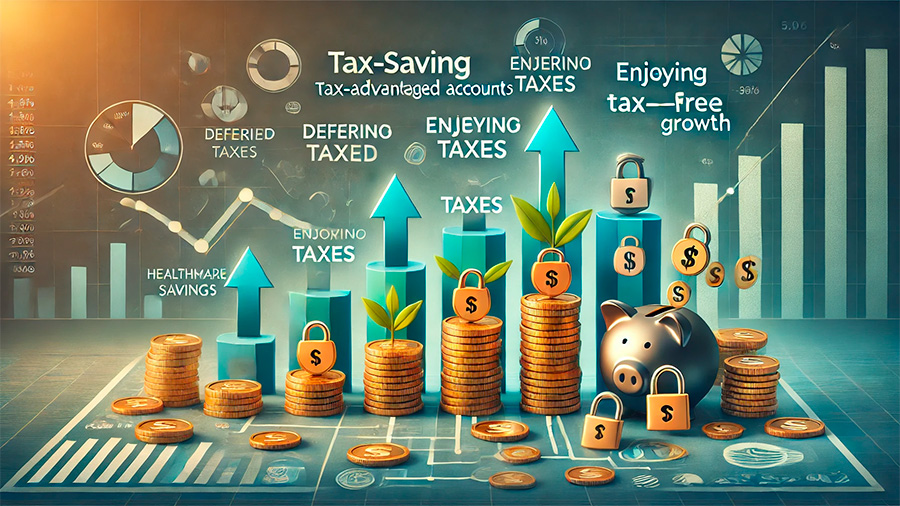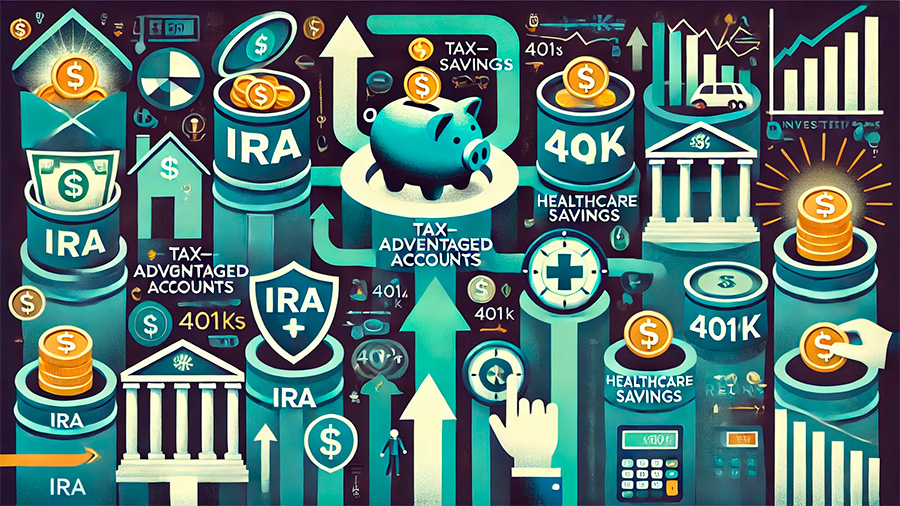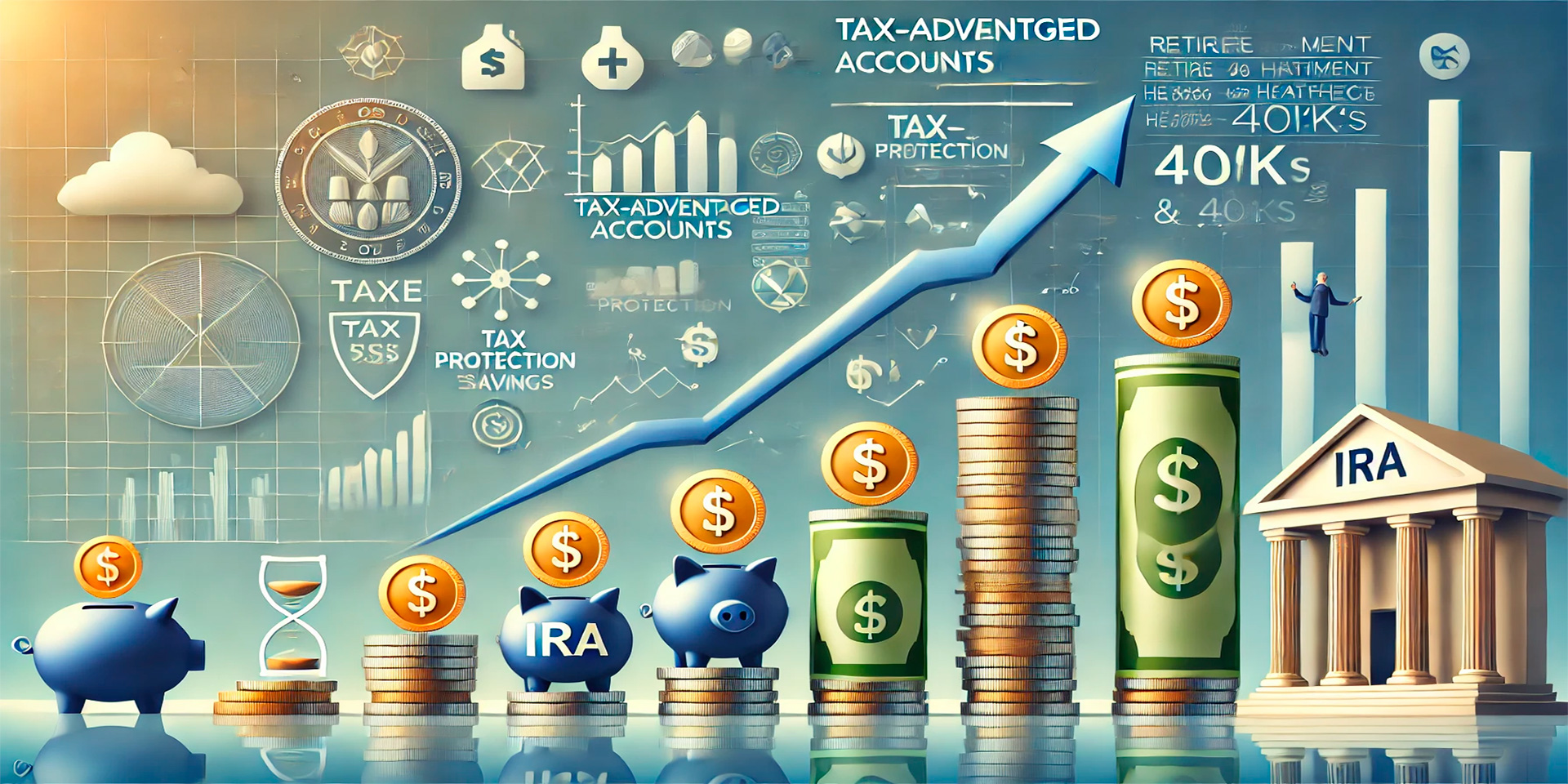Boosting Your Investments: The Power of Tax-Advantaged Accounts for Financial Growth
Tax-advantaged accounts, such as Individual Retirement Accounts (IRAs) and 401(k)s, offer significant benefits for investors looking to grow their wealth faster. By allowing you to defer taxes or enjoy tax-free growth, these accounts provide a powerful tool to maximize the long-term value of your investments. For ordinary investors, taking full advantage of tax-advantaged accounts can mean substantial savings, compounding returns, and a more comfortable financial future.
Whether you’re planning for retirement, saving for healthcare costs, or simply looking for ways to reduce your tax burden, tax-advantaged accounts are an essential part of any investment strategy. Understanding how these accounts work, their benefits, and how to use them effectively can make a significant difference in your ability to grow your investments and achieve your financial goals.
In this article, we will explore the different types of tax-advantaged accounts, how they can help you save on taxes, and strategies for using them to maximize your investment returns.
Types of Tax-Advantaged Accounts
There are several types of tax-advantaged accounts, each offering unique benefits for different financial goals. Here are the most common accounts that can help you save on taxes while growing your investments.
1. Individual Retirement Accounts (IRAs)
IRAs are designed to help individuals save for retirement with tax benefits that encourage long-term investing. There are two main types of IRAs: Traditional IRAs and Roth IRAs.
- Traditional IRA: Contributions to a Traditional IRA are typically tax-deductible, meaning you reduce your taxable income in the year you make the contribution. The funds in the account grow tax-deferred, and you only pay taxes when you withdraw the money in retirement. However, withdrawals are taxed as ordinary income, and there are penalties for withdrawing funds before the age of 59½.
- Roth IRA: Contributions to a Roth IRA are made with after-tax dollars, meaning you do not get a tax deduction for your contributions. However, the major benefit is that your investments grow tax-free, and qualified withdrawals in retirement are also tax-free. Roth IRAs are particularly beneficial for individuals who expect to be in a higher tax bracket in the future.
Both Traditional and Roth IRAs offer significant tax advantages that can help you grow your retirement savings faster than a regular taxable account.
2. 401(k) Plans
401(k) plans are employer-sponsored retirement accounts that offer tax-deferred growth, making them one of the most popular tax-advantaged investment options. Contributions to a 401(k) are made with pre-tax dollars, meaning they reduce your taxable income for the year, and the investments grow tax-deferred.
- Employer match: Many employers offer a matching contribution, which means they will contribute additional funds to your 401(k) based on the amount you contribute. This is essentially “free money” that can significantly boost your retirement savings.
- Tax benefits: Like a Traditional IRA, the money in a 401(k) grows tax-deferred, and you only pay taxes when you withdraw funds in retirement. This allows your investments to compound more effectively over time.
A 401(k) is one of the most powerful tools for retirement savings, especially if your employer offers matching contributions.
3. Health Savings Accounts (HSAs)
Health Savings Accounts (HSAs) offer triple tax benefits, making them one of the most tax-advantaged accounts available. HSAs are designed to help individuals with high-deductible health plans save for medical expenses, but they can also be used as a retirement savings tool.
- Triple tax advantage: Contributions to an HSA are tax-deductible, the money grows tax-free, and withdrawals for qualified medical expenses are also tax-free. If you use the funds for non-medical expenses after age 65, withdrawals are taxed as ordinary income, similar to a Traditional IRA.
- Investment opportunities: Many HSA providers allow you to invest the funds in your account, which means you can grow your HSA balance over time while enjoying the tax advantages.
HSAs are an excellent way to save for both medical expenses and retirement, making them a versatile option for tax-advantaged investing.

How Tax-Advantaged Accounts Help You Save on Taxes
The primary benefit of tax-advantaged accounts is their ability to reduce your tax burden, either by deferring taxes or providing tax-free growth. Here’s how these accounts can help you save on taxes and grow your investments faster.
1. Tax Deferral on Contributions
One of the key advantages of accounts like Traditional IRAs and 401(k)s is the ability to defer taxes on contributions. This means that you do not pay taxes on the money you contribute to these accounts until you withdraw the funds in retirement.
- Lower taxable income: By contributing to a tax-deferred account, you lower your taxable income for the year, which can reduce the amount you owe in taxes. For example, if you contribute $5,000 to a Traditional IRA or 401(k), your taxable income for the year is reduced by that amount.
- Compounding without taxes: In a regular taxable investment account, you pay taxes on interest, dividends, and capital gains as they are earned. In a tax-deferred account, your investments can grow without being taxed, allowing the full value of your investments to compound over time.
The ability to defer taxes on contributions allows your investments to grow more efficiently, potentially leading to larger account balances by the time you retire.
2. Tax-Free Growth and Withdrawals
Roth IRAs and HSAs offer the benefit of tax-free growth, meaning that once you’ve contributed after-tax dollars to these accounts, your investments grow without any further tax liability. In addition, qualified withdrawals from these accounts are completely tax-free.
- Roth IRA withdrawals: Once you reach age 59½ and have had the account for at least five years, you can withdraw your Roth IRA contributions and earnings without paying any taxes. This makes a Roth IRA particularly advantageous for individuals who expect to be in a higher tax bracket during retirement.
- HSA withdrawals: If you use HSA funds for qualified medical expenses, you can withdraw the money tax-free at any time. After age 65, you can also use HSA funds for non-medical expenses, though these withdrawals are taxed as ordinary income.
Tax-free growth and withdrawals allow you to keep more of your investment gains, helping your money last longer in retirement or cover healthcare costs.
3. Employer Contributions and Matching
Employer-sponsored retirement accounts like 401(k)s often come with matching contributions from your employer. This is essentially free money added to your retirement savings, and it is not included in your taxable income until you withdraw it in retirement.
- Maximizing employer match: If your employer offers a 401(k) match, be sure to contribute enough to take full advantage of it. For example, if your employer matches 50% of your contributions up to 6% of your salary, contributing 6% ensures you receive the maximum match available.
Employer matching contributions can significantly boost your retirement savings while offering additional tax benefits.

Strategies for Using Tax-Advantaged Accounts to Maximize Investments
To make the most of tax-advantaged accounts, you need a strategic approach to ensure that your investments are working efficiently to grow your wealth. Here are some key strategies to consider.
1. Maximize Contributions Each Year
Each tax-advantaged account has annual contribution limits, and it’s important to contribute as much as possible to maximize your tax savings and investment growth.
- IRA contribution limits: For 2023, the maximum contribution to an IRA (both Traditional and Roth) is $6,500 if you’re under age 50, and $7,500 if you’re 50 or older.
- 401(k) contribution limits: For 2023, the maximum contribution to a 401(k) is $22,500 if you’re under 50, and $30,000 if you’re 50 or older.
- HSA contribution limits: For 2023, the maximum contribution to an HSA is $3,850 for individuals and $7,750 for families, with an additional $1,000 catch-up contribution for those 55 or older.
Maximizing your contributions each year helps you take full advantage of the tax benefits and grow your investments more quickly.
2. Consider Tax Diversification
Tax diversification involves holding a mix of tax-deferred and tax-free accounts to provide flexibility in retirement. By having both Traditional (tax-deferred) and Roth (tax-free) accounts, you can better manage your tax liability in retirement by choosing which accounts to withdraw from based on your tax situation.
- Balancing contributions: Contributing to both a Traditional IRA or 401(k) and a Roth IRA allows you to balance your current tax savings with future tax-free withdrawals. This strategy can be particularly useful if you expect to be in a higher tax bracket during retirement.
Tax diversification gives you greater control over your tax situation in retirement, allowing you to minimize taxes while preserving more of your wealth.
3. Use HSAs as a Retirement Savings Tool
While HSAs are primarily designed to cover medical expenses, they can also be used as an additional retirement savings tool. By allowing the funds to grow tax-free and using them for non-medical expenses after age 65, HSAs offer similar benefits to a Traditional IRA.
- Invest HSA funds: Many HSA providers allow you to invest the funds in your account, which can help you grow your balance over time. Consider using your HSA as both a healthcare savings account and a retirement account by investing the funds and letting them grow until you need them in retirement.
- Tax-free withdrawals for healthcare: Given that healthcare costs are one of the largest expenses in retirement, using an HSA to cover medical expenses tax-free can significantly reduce your financial burden in retirement.
Using an HSA as part of your retirement strategy allows you to enjoy triple tax benefits while covering healthcare costs and growing your investments.
Final Thoughts: Maximizing Investments Through Tax-Advantaged Accounts
Tax-advantaged accounts are one of the most effective tools for growing your investments faster while minimizing your tax burden. By contributing to accounts like IRAs, 401(k)s, and HSAs, you can take full advantage of tax deferral, tax-free growth, and employer contributions, all of which help your investments compound more efficiently over time.
Whether you’re saving for retirement, managing healthcare costs, or simply looking for ways to reduce your taxable income, using tax-advantaged accounts strategically is key to building long-term financial security. By maximizing your contributions, diversifying your accounts, and focusing on long-term growth, you can ensure that your investments grow in the most tax-efficient way possible, helping you achieve your financial goals faster and with greater confidence.

